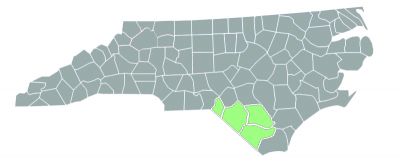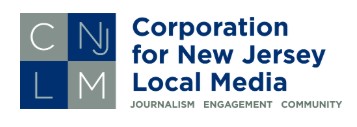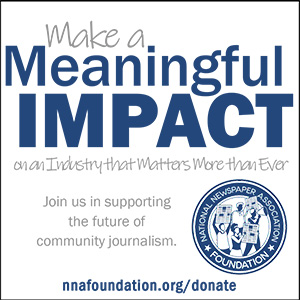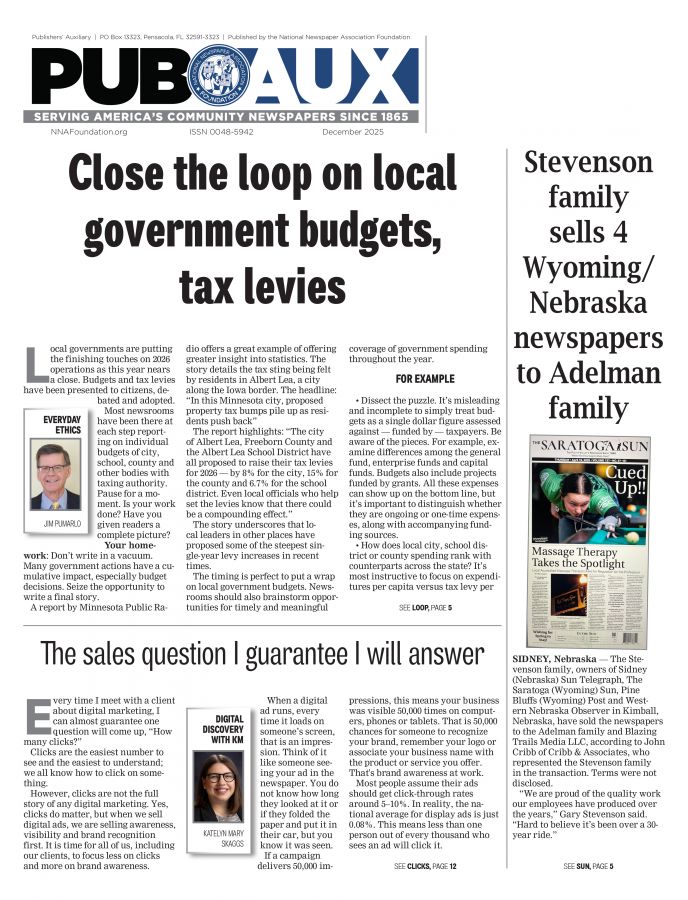Les High, legacy publisher in North Carolina, establishes center for local investigative journalism
Teri Saylor
Special to Publishers' Auxiliary
May 1, 2021

TERI SAYLOR AND LES HIGH
for the National Newspaper Association Foundation
Les High, publisher of The News Reporter, a family newspaper in Whiteville, North Carolina, has founded The Border Belt Center, a burgeoning nonprofit journalism organization that will begin publishing online as the Border Belt Independent in May.
Using a $495,000 grant from the Kate B. Reynolds Charitable Trust over the next three years, High will build a team of journalists who will publish in-depth stories about issues facing Bladen, Columbus, Robeson and Scotland counties in southeastern North Carolina, one of the poorest areas in the state.
On the Border Belt Independent’s website, High explains that the new organization will focus primarily on the challenges faced by rural North Carolina counties, such as education, poverty, health, mental health and issues that adversely affect individuals based on age, race and the economy.
“We’ll provide context and analysis of these issues and highlight the influencers who seek to bring about change,” High said. “When we publish stories that examine these challenges, we’ll also try to find solutions.”
Stories will be published online at the Border Belt Independent, in an email newsletter, and across social media platforms. Many will also be printed in local newspapers and distributed to statewide media outlets. The Border Belt Independent site, when completed, can be found at https://borderbeltindependent.org/.
High follows in the footsteps of his father, the late James C. “Jim” High, who served as publisher of The News Reporter for 61 years and was one of Columbus County’s strongest civic leaders. Les High has worked at the newspaper his entire career after graduating from the University of North Carolina’s School of Journalism in 1984. The News Reporter is a media company founded in 1896. The Pulitzer Prize-winning newspaper is published twice a week with a circulation of more than 8,100.
The News Reporter is published twice a week with a circulation of more than 8,100. Its website is located at https://nrcolumbus.com/. NR Digital Services is the company’s in-house digital advertising agency.
Now, as the founder of the Border Belt Center, High hopes to revive the mission of the Fourth Estate to improve communities by shining a light in dark corners, holding public officials accountable and protecting democracy.
Pub Aux: How did this news organization come about?
High: It was something I've been thinking about for a long time. I met Adam Linker, director of programs for the Kate B. Reynolds Charitable Trust when he was the program officer serving the eastern North Carolina region for the trust’s health care division. KBR doesn’t just throw money at programs; they have people on the ground determining where funds can best be spent. Adam is a former journalist and he understands our challenges. He and I had many conversations about rural regions – and even in other areas where you've got diminished journalism capacity. KBR is primarily focused on issues like health, adverse childhood experiences and the like, but it’s hard to fix these problems if you can’t identify what they are. And that was kind of the genesis of this idea, trying to put boots on the ground so we can find out what the problems are. And the hope is that we can provide solutions.
You already had a grant from the North Carolina Local News Lab Fund. Did that help you win the KBR grant, because that’s a really sizable, amazing grant?
High: We were very fortunate that Lizzie Hazeltine, the North Carolina Local News Lab fund coordinator, and Melanie Sill, interim executive director and Pulitzer Prize-winning editor, were involved. They also recognize the need. We used the $10,000 news lab grant to do a feasibility study, which I think demonstrated to the KBR board the seriousness of this effort, not just on our part, but for people across the state. So the North Carolina Local News Lab Fund underwrote that study, and certainly whenever you can show the need and a path forward that helps with other funding.
Describe your feasibility study.
High: We commissioned Carol Wolf, who is a former business journalism lecturer at the Walter E. Hussman School of Journalism at UNC-Chapel Hill. She had an understanding of both journalism and business, and since UNC is a public university that serves the people of the state, the university has major interest in this topic. This was particularly the case with Penny Abernathy, who was with the school of journalism for many years and was the creator of the news deserts study that warns we're headed for real trouble, not just in journalism, but also in our democracy, because of the massive disruption of newspapers. She’s been a big help and influence.
What were some of the things you are looking at through the Border Belt Center and Border Belt Independent?
High: For many years, the area was known as the Border Belt, reflecting the thriving tobacco markets that are now long gone. If you look at statistics, these are among the poorest counties in the state. The persistent poverty creates many challenges – healthcare, mental health, education, lack of opportunity, and challenges with children and their inability to escape generational poverty.
The Kate B. Reynolds Trust cares deeply about these issues and that children don't have the same advantages that children in wealthier parts of the state have. If you look at the demographics of those four counties it gives you a picture of challenges they face, and they can predict similar challenges in other rural counties. Among the goals KBR and newspapers share is we try to help people in underserved areas live better lives. It’s important to note that KBR and the Border Belt Center have an understanding that grantors won’t have any sway over content or editorial decisions, but our missions are closely aligned.
Working through your newspaper, The News Reporter, these are probably some areas that you have covered in the past, maybe along the lines of your normal coverage, but you didn't have the resources to really do a deep dive into these issues.
High: Exactly. This area is covered by six newspapers: The Tabor-Loris Tribune, The News Reporter, The Bladen Journal, The Robesonian, the Laurinburg Exchange and the UNC Pembroke student newspaper, The Pine Needle. And in today’s landscape, no one has the financial resources to add the staff we once had. We have enough to cover city council, county commissioners, school boards, some police, but we don't have the bandwidth to do in-depth investigative stories that can really change things and hold powerful people accountable. And one of the goals of the Border Belt Center is to provide the bandwidth to do this. It was important for the area newspapers to understand that we are not competitors. This is a partnership. Some of our reporting will be done in partnership with these newspapers. Some will be county specific, but some will look at issues across all four counties.
How will the collaboration work? Will you use your grant money to provide reporters to cover their counties, or will you find a way to help them use their own reporters?
High: Collaboration is such a big movement in journalism today, thank goodness. We all used to be super competitive – we protected our sources, protected our stories. I mean, it was the Wild West that drove better journalism in a lot of ways. But now, because we don't have the bandwidth, we realize we've got to work together and collaborate.
We're going to hire one lead investigative reporter and have one part-time reporter to start with and move to having two investigative reporters. We will use freelancers for writing and photography. We’ll do some visual storytelling where the story is told through video and photography. I think in this day and age you have to do more than just wordsmiths. It's got to involve social media and visual elements because that's how people get their news. It’s also important to us that the journalism be written not just for an elite audience - we want the people who live in these four counties to take ownership in it and to understand that the journalism we're doing is not just a means to an end, it's there to help them.
What was the purpose of creating a nonprofit news site as opposed to trying to expand your newspaper’s coverage?
High: I knew if we want to try to solve the problems and challenges our communities face, the nonprofit route seems to be the best model, with KBR as a key player and with other entities that share an understanding of the importance of trying to solve those challenges. I don’t see the traditional for-profit model working in this instance.
How did you create your structure?
High: In this case, we ran the KBR contribution through the North Carolina Press Foundation, a 501(c)3, which is serving as our fiscal sponsor.
The next step is becoming a federal 501(c)3 nonprofit so we can receive tax-deductible contributions, but that process takes several months. In the past, NCPF’s fiscal sponsorship was primarily a way for the newspapers across the state and the NCPA to fund NIE programs and educational programs. But the board was really interested in trying to extend its reach by being a fiscal sponsor for a new idea like the Border Belt Center.
Right now, the KBR grant provides $165,000 a year, which gives us a great foundation to establish a budget that we know we can rely on for the next three years. And as we build our reputation and our capacity and our reach, and when we have our 501(c)3 status, we will reach out for other grants to support specific reporting projects such as education or health or environmental issues.
How are you growing your audience? Are you relying on your current readers?
High: We're collaborating with the UNC Kenan-Flagler School of Business MBA program, one of the best in the country, using their marketing and venture capital clubs to create a competition to help us develop marketing streams. Our collaboration with the region’s newspapers will help us develop audience. I’m an old-school journalist, not a master of social media and marketing, so I’m interested to see what the MBA competition will show us. I can’t emphasize this enough, but for anyone looking to start a nonprofit site, seek out collaborators in every possible area. I’ve found that universities in particular want to help.
Do you envision eventually distributing stories to other newspapers and outlets across the state?
High: When we do a story, it’s going to be posted at borderbeltindependent.org. We’re planning on a mid-May launch. After the stories are posted, we’ll provide copy and high-resolution images to the newspapers in our area so they can publish them in print to help build their readership. They can also post them on their websites to help their online traffic. I imagine we’ll do some stories that will have statewide impact, and we hope they will be picked up by other outlets and newspapers. As we delve further into visual, we hope to provide packages for TV stations and even radio.
What is your structure? Will you serve as executive director or publisher? And is it completely separate from the newspaper?
High: We are building an advisory board and board of directors as we begin the process of becoming a 501(c)3. I am the interim editor, and as we move forward, we’ll have a more formal board of directors. Right now, we have basic bylaws, and the next step is to develop specific bylaws that guide our operation.
Do you envision ever having a print newspaper to go along with your site?
High: No, we won't produce a paper or sell advertising. That's where the newspapers in the region make their money, and we don't want in any way to infringe on what these newspapers are trying to do. There are two primary goals of the Border Belt Center: first, to tell stories that will make people’s lives better, and second, to make sure that local journalism, which means our local papers, survive. When you lose your local newspaper, the vacuum that’s created is typically a very dark place.
And I know you've talked kind of around this, but what do you envision for the future?
High: When I graduated from journalism school in Chapel Hill, I took a week off and then went straight to work as a journalist at The News Reporter. It’s been a rewarding 36 years. Writing stories, taking pictures, getting up in the middle of the night to cover spot news, and then getting really involved with our staff transforming our paper from one that was all about print to a 24/7 digital newsroom that’s focused on reader revenue and online delivery of the news. We've been successful, but looking at the landscape around us, I had a great concern that the weight and importance that local newspapers carried and the influence they had for the greater good of their communities was waning. When you don't have strong journalism in communities, democracy suffers. It’s been clearly proven that when you don't have a watchdog newspaper, corruption and other problems ensue when there is no accountability. And I started thinking about ways to get a grant for news coverage and build more investigative capacity for our local newspaper.
And then I thought about how we might expand this to a rural region like these four counties and I said OK, so if we can make this work here, can we replicate this in other rural regions of North Carolina and the nation? What really has propelled me at this stage of my career is not just thinking about The News Reporter, but about how journalism is so integral in our democracy. We've seen that come under real threat in the past few years. And what can we as journalists do to share the responsibility of being an active, important player in continuing our democracy?
What is some advice for other community newspaper publishers who might be interested in doing something similar?
High: Publishers should look to see what they might do in terms of partnering with a nonprofit entity. I think it was The Fresno (California) Bee that added a number of reporting positions through local nonprofit grants even though it's a private newspaper. Collaboration with other news organizations is important. Start talking with area publishers and find a common thread. Then seek ways to connect and form an entity or plan a project that could be funded by a grant. Then look for a nonprofit foundation willing to serve as a fiscal sponsor.
Nonprofit news organizations are also a great place for journalism schools to place their students who want to do good journalism. So I think there could be more partnerships between colleges and universities and nonprofit news organizations. UNCP draws students from around the area and those kids are really engaged in their communities. We need to get those kids involved because through them, we’ll get a much better feel for what is going on in their communities. UNCP is also has a very diverse student population, and all newsrooms need to better reflect that diversity, including ours.
Would another good piece of advice be to ask for help?
High: I've reached out to a lot of people and they've all been willing to help because I think everybody in journalism understands the pressures and threats that journalism is under. Everyone I've reached out to has been very encouraging because they understand that we've got to try new things to reach people, to reach out to new audiences.
And there are just so many ways to do that. Is this a model that can make that happen? If so, can we replicate it in other areas? I hope we can.
Any final thoughts?
High: My grandfather, Leslie Thompson, was publisher of The News Reporter in 1953 when it won the Pulitzer Prize with the Tabor City (North Carolina) Tribune for its fight against the Ku Klux Klan, which had infiltrated law enforcement in the county. That fight took a lot of courage. Both publishers could have lost their businesses or even their lives. I’ve often thought about their legacy and how that translates to 2021. I believe that reporters today have at least as much, if not more, courage to carry on those fights than they did in the prime of newspapers. It was easier then. Reporters have far fewer resources and there’s always the fear of losing their jobs. It doesn’t help when our leaders label journalists as enemies of the people; yet, we carry on when the tough stories are required. So I think if we can all start thinking more in terms of collaboration and looking to nonprofits to provide reporting capacity, we can do the kinds of stories our communities deserve in today’s environment of willful disinformation from sources that lack trust.
Teri Saylor is a writer in North Carolina. Reach out to her at terisaylor@hotmail.com










